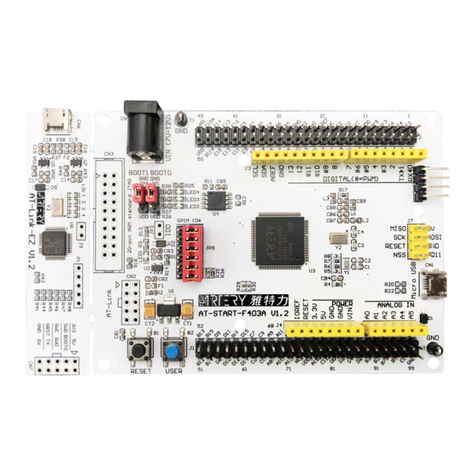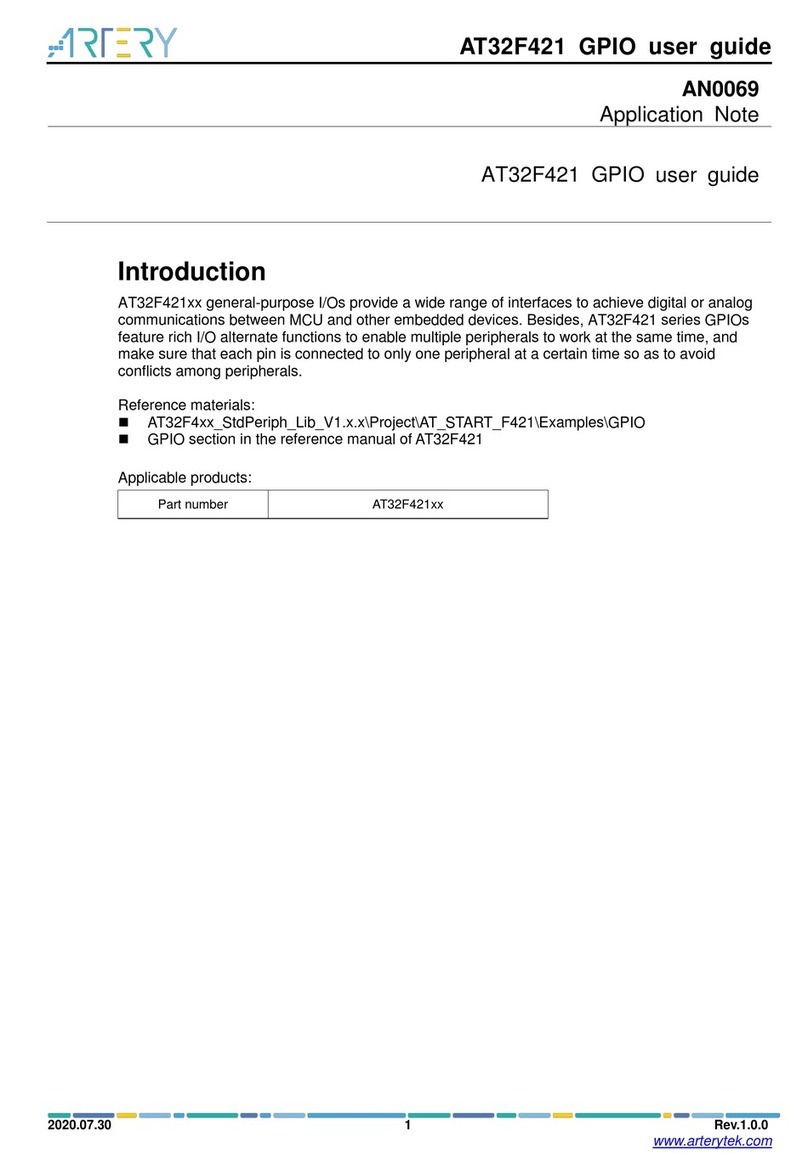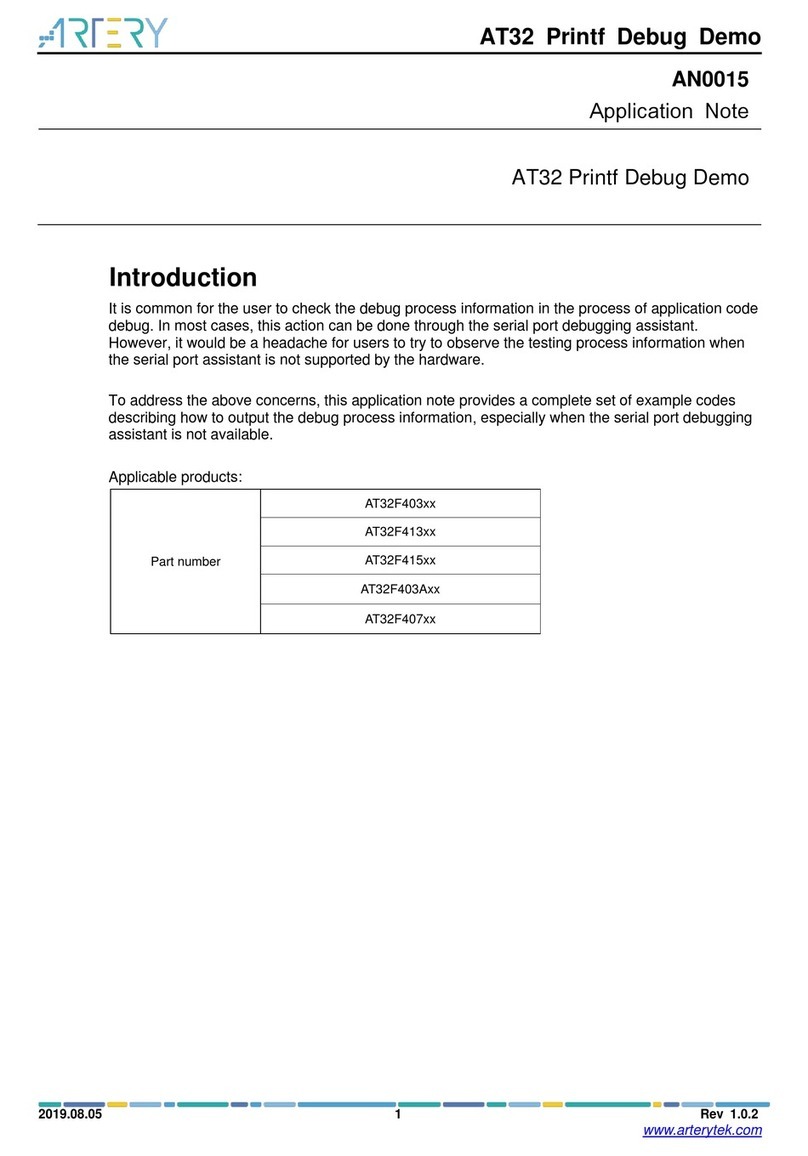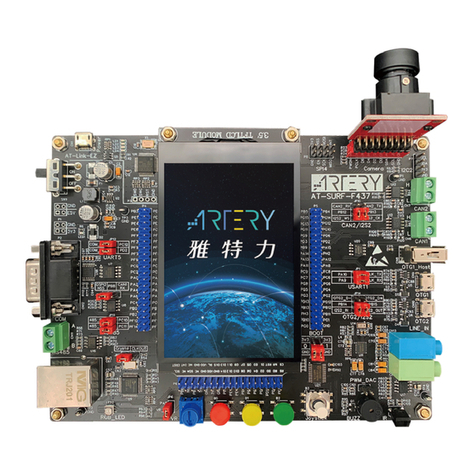
AT32F415 Series Reference Manual
2020.06.28 Page 1 Version 1.02
ARM®-based32-bit Cortex®-M4 MCU, with 64 Kbyte ~ 256 Kbyte Internal Flash,
sLib, USB-OTG, 11 Timers, 2 COMPs,1 ADC, 12 Communication Interfaces
Function
Core: ARM®32-bit Cortex®-M4 CPU
−Operating rate up to 150 MHz, with
Memory Protection Unit (MPU),
embedded single cycle multiplication
and hardware division
−DSP instruction set provided
Memory
−From 64 Kbyte to 256 Kbyte internal
Flash program/data memory
−18 Kbytes of system memory used as a
Bootloader or as a general
instruction/data memory (one-time-
configured)
−Up to 32 Kbyte SRAM
−sLib: configurable part of main Flash set
as a library area with code excutable but
secured, non-readable
Clock, Reset, and Power Management
−2.6 V ~ 3.6 V and I/O pins
−Power-on/Power-down Reset (POR/PDR),
Programmable Voltage Detector (PVD)
−4 to 25 MHz crystal oscillator
−Internal48 MHz RC factory-trimmed RC
(accuracy 1% at TA=25 °C, 2.5% at TA= -
40 to 105°C )
−Internal 40 kHz RC with calibration
−32 kHz oscillator with calibration
Low Power Consumption
−Sleep, Stop, and Standby mode
−VBAT support for RTC and twenty 32-bit
backup registers
One 12-bit, 0.5 μs A/D converter (Up to 16
input channels)
−Conversion range: 0 V ~ 3.6 V
−One sample –and- hold capability
−Temparature sensor
Two analog comparators
DMA: 14-channel DMA controller
−Peripherals supported: Timer, ADC,
SDIO, I2Ss, SPIs, I2Cs and USARTs
Debug Mode
−Serial Wire Debug (SWD) and JTAG interface
Up to 55 Fast I/Os
−27/39/55/multi-functional bidirectional
I/Os, all mappable to 16 external
interrupt vectors and almost 5 V-tolerant
Up to 11 Timers
−Up to 5 16-bit timers + 2 32-bit timers;
each with 4 IC/OC/PWM or pulse counter
and incremental encoder input.
−1 16-bit motor control PWM and
advanced timers with dead-time
generator and emergency stop
−2 Watchdog timers (independent and
window)
−SysTick timer: a 24-bit downcounter
ERTC: enhanced RTC with subsecond
accuracy and hardware calendar
Up to 12 Communication Interfaces
−2 x I2C interfaces (SMBus/PMBus)
−Up to 5 USARTs (ISO7816 interface, LIN,
IrDA capability, and modem control)
−2 x SPIs (50 Mbit/s), both with I2S interfaces
multiplexed
−CAN interface (2.0B active) with
dedicated 256 bytes SRAM
−USB2.0 full-speed device/host/OTG
controller with dedicated 1280 bytes
SRAM, device mode supporting cystal-
less
−SDIO interface
CRC Calculation Unit
96-bit unique ID (UID)
Packaging
−LQFP64 10x10 mm
−LQFP64 7x7 mm
−LQFP48 7x 7 mm
−LQFP48 6 x 6 mm
−QFN32 4 x 4 mm
List of Models
Table 1. Device summary
AT32F415RCT7, AT32F415RCT7-7,
AT32F415CCT7, AT32F415CCU7,
AT32F415KCU7-4
AT32F415RBT7, AT32F415RBT7-7,
AT32F415CBT7, AT32F415CBU7,
AT32F415KBU7-4
AT32F415R8T7, AT32F415R8T7-7,
AT32F415C8T7, AT32F415K8U7-4


































